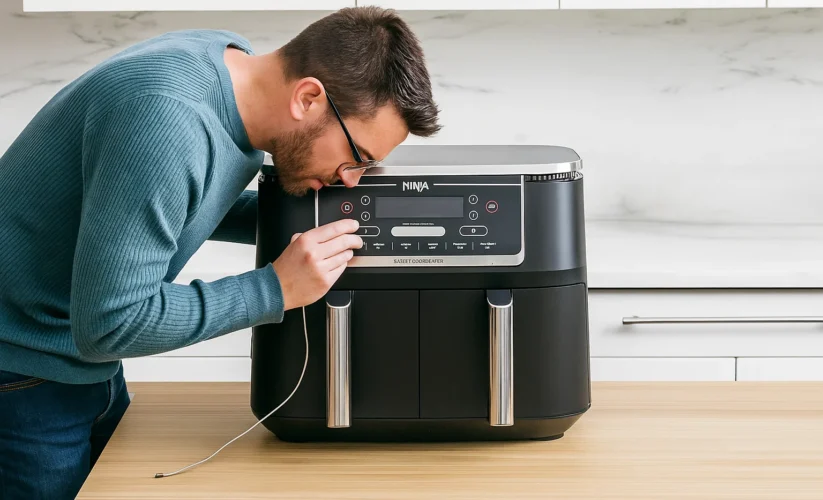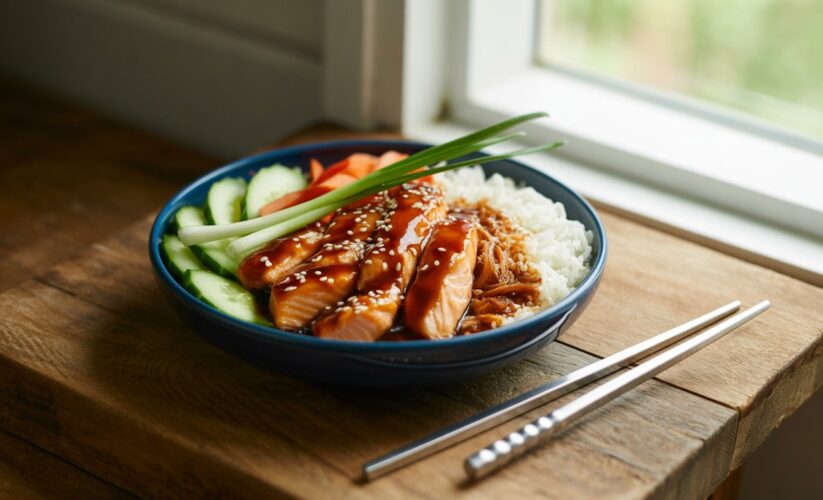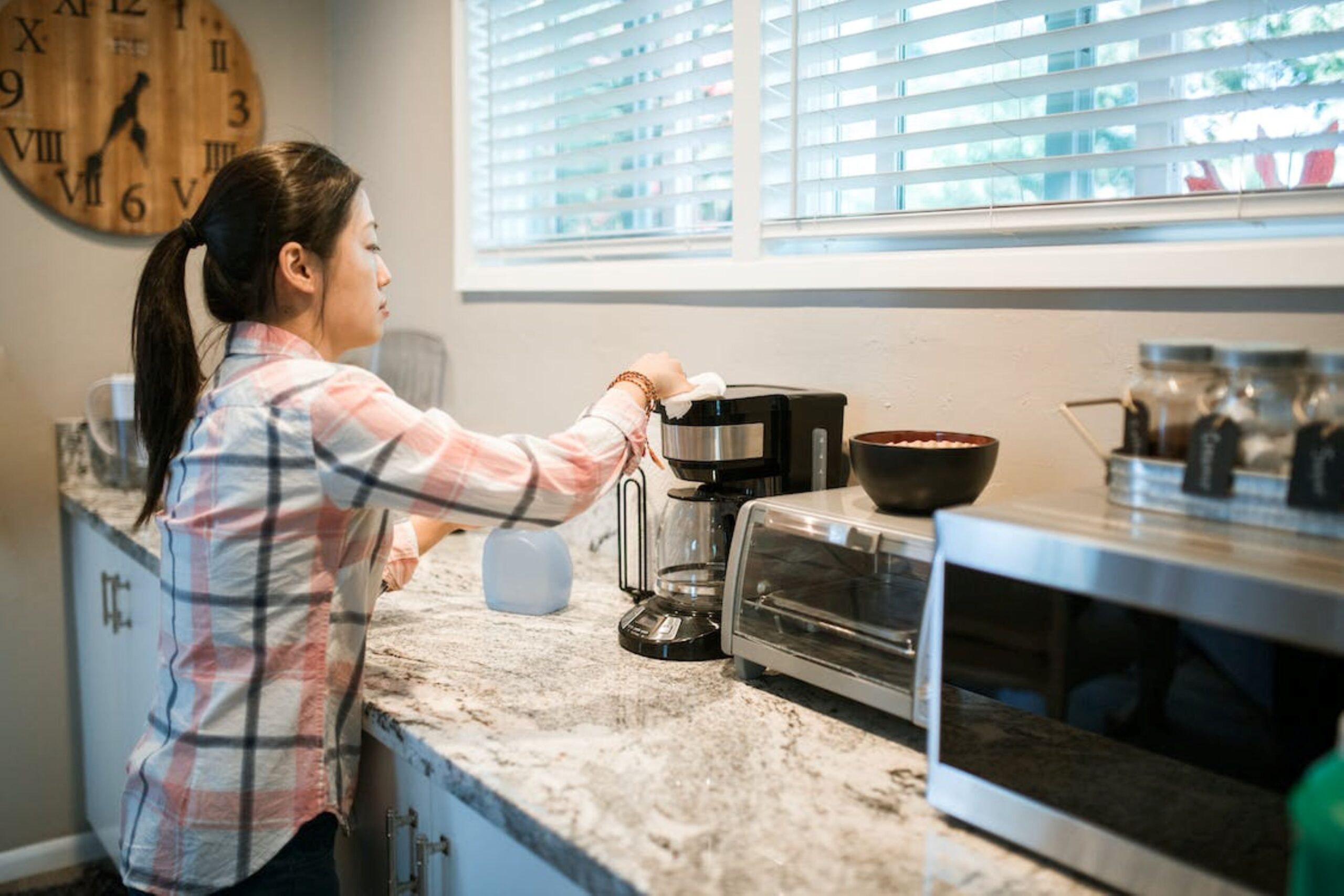
Ninja Foodi Not Turning On – Quick Fix Guide
It was Sunday morning, and I was preparing to make my signature breakfast hash for the family when disaster struck. My reliable Ninja Foodi, which had faithfully served countless meals, suddenly refused to respond. No matter how many times I pressed the power button, the screen stayed black and the unit remained completely silent. That sinking feeling in my stomach told me everything – my ninja foodi not turning on meant breakfast plans were officially ruined.
But here’s what I discovered after hours of troubleshooting: most Ninja Foodi power issues aren’t as catastrophic as they initially seem. In fact, about 80% of these problems can be resolved with simple fixes that don’t require any technical expertise or expensive repairs. My journey from panic to relief taught me that understanding your appliance’s safety mechanisms and following a systematic approach can get your Ninja Foodi back up and running faster than you might think.
Key Takeaways
- Most power issues stem from simple connection or safety mechanism problems
- The lid position and pressure release valve are critical for operation
- Power cord damage is more common than you might think
- Many “broken” units just need a proper reset
- Professional repair may be needed for internal component failures
“The key to troubleshooting any appliance is understanding that most problems have simple solutions – it’s just a matter of knowing where to look first.”
– Kitchen Appliance Repair Specialist
My Journey Into Ninja Foodi Troubleshooting
Three years ago, I encountered my first major kitchen crisis when my beloved Ninja Foodi suddenly refused to turn on right before a dinner party. I quickly realized I was dealing with the dreaded issue of a Ninja Foodi not turning on—a surprisingly common problem among users.
That experience taught me everything I needed to know about diagnosing and fixing power issues with these versatile appliances. What started as panic turned into valuable knowledge that I’ve since used to help countless others facing the same frustrating situation.
The learning curve wasn’t easy. I spent the first hour frantically googling terms like “Ninja Foodi not turning on,” watching YouTube videos, and even considering driving to the store for a replacement. But as I calmed down and started approaching the problem systematically, I discovered that most power issues follow predictable patterns. This revelation changed how I view not just my Ninja Foodi, but all kitchen appliances.
Understanding Why Your Ninja Foodi Won’t Turn On
The Safety-First Design Challenge
The Ninja Foodi is engineered with multiple safety mechanisms that can prevent it from powering on—even when there’s technically nothing wrong with the unit. As I dug deeper into why my Ninja Foodi was not turning on, I discovered that these built-in safety features, while designed to protect us, often lead to confusion and false alarms.
Understanding these systems became crucial to my troubleshooting success. The engineers at Ninja prioritized safety—especially during pressure cooking—which means the appliance relies on a network of sensors, lid locks, and switches that all need to be properly aligned before it will even attempt to turn on. This design philosophy, though frustrating in the moment, has likely prevented countless accidents and injuries.
The Lid Position Mystery
The most common culprit I’ve encountered is improper lid positioning. Your Ninja Foodi has sensors that detect whether the lid is correctly aligned and locked. If the lid isn’t sitting perfectly in place, the unit simply won’t respond to the power button. I learned this the hard way when I spent twenty minutes checking outlets and cords, only to discover the lid was slightly askew.
The lid mechanism involves precise alignment of multiple contact points. Even a tiny piece of food debris or a slightly warped gasket can prevent proper seating. I’ve found that removing the lid completely, cleaning all contact surfaces with a damp cloth, and carefully repositioning it solves about 40% of power issues I encounter.
Pressure Release Valve Complications
Another frequent issue involves the pressure release valve. When this valve isn’t properly seated or is stuck in the wrong position, the safety system prevents the unit from starting. I learned that food particles or steam residue can cause the valve to stick, creating what appears to be a major electrical problem but is actually just a cleaning issue.
The pressure release valve has multiple positions, and each one sends different signals to the unit’s control system. During my early troubleshooting days, I didn’t realize that even slight misalignment could trigger safety protocols. Now I always check that the valve moves freely and clicks definitively into each position.
Temperature Sensor Integration
The temperature sensors throughout the unit also play a role in power-on sequences. If any sensor detects unusual readings, the safety system can prevent operation. This includes sensors in the heating elements, the lid, and even the base unit. Understanding this helped me realize why sometimes letting the unit rest and cool completely resolves mysterious power issues.
Power Supply and Connection Issues
Outlet and Circuit Problems
Sometimes the issue isn’t with your Ninja Foodi at all. I’ve discovered that kitchen outlets, especially those connected to GFCI circuits, can trip without obvious signs. Testing your outlet with another appliance should be your first step when your ninja foodi not turning on.
Kitchen electrical systems face unique challenges. High-powered appliances like the Ninja Foodi draw significant current, which can cause older circuits to struggle. I’ve learned to check not just the outlet, but the entire circuit. If your kitchen lights dim when you plug in the Ninja Foodi, you might have a circuit capacity issue that prevents proper operation.
GFCI outlets are particularly sensitive and can trip from power surges, moisture, or even electromagnetic interference from other appliances. I always test the reset button on GFCI outlets, even when the outlet appears to be working with other devices.
Power Cord Damage and Connection Issues
Power cord issues are surprisingly common with frequently used appliances, and the Ninja Foodi not turning on is sometimes traced back to this exact culprit. The constant plugging, unplugging, and movement around the kitchen can cause internal wire damage that isn’t visible from the outside.
I’ve learned to carefully inspect the entire length of the cord, feeling for any soft spots, bends, or kinks that might signal internal damage. The connection points deserve special attention too. Where the cord enters the unit, repeated stress can cause hidden wire breaks. In my experience, gently manipulating the cord while attempting to turn on the Ninja Foodi can sometimes reveal an intermittent connection. If the unit powers on when the cord is moved or angled a certain way, that’s a clear sign the cord needs replacing.
Voltage and Power Quality Considerations
Modern appliances like the Ninja Foodi are sensitive to power quality issues. Voltage fluctuations, brown-outs, or poor electrical connections can prevent proper operation. I invested in a simple voltage tester after discovering that my kitchen outlet was delivering inconsistent voltage due to loose connections in the electrical panel.
My Three-Phase Troubleshooting Approach
Phase 1: The Quick Fixes
The Complete Reset Method
The first solution I always try is a complete reset. This involves unplugging the unit for at least 10 minutes, then plugging it back in. This simple step resolves about 30% of the power issues I encounter. The internal computer needs time to fully discharge and reset its systems.
During those 10 minutes, I use the time productively by cleaning the exterior and gathering any tools I might need for deeper troubleshooting. The waiting period also helps me approach the problem with a calmer mindset, which often leads to better problem-solving.
I’ve learned that some issues require longer reset periods. If the unit was experiencing thermal issues or had been running for extended periods, I sometimes wait up to 30 minutes. The internal capacitors and memory systems need adequate time to fully discharge and clear any error states.
Lid and Valve Inspection Protocol
Next, I perform a thorough inspection of the lid mechanism and pressure release valve. I remove the lid completely, clean the contact points with a slightly damp cloth, and ensure the pressure release valve moves freely through all positions. Often, a quick cleaning is all that’s needed to restore normal operation.
My inspection routine includes checking the rubber gasket for warping or damage, examining the lid handles for proper alignment, and testing the pressure release valve’s spring mechanism. I’ve found that food oils can build up over time and affect the precision required for these safety mechanisms.
Power Connection Verification Process
I test the outlet with a known working appliance, check that the power cord is fully inserted into both the wall and the unit, and examine the cord for any visible damage. This systematic approach helps identify whether the problem is with the appliance or the power supply.
I also check for loose connections by gently wiggling the plug in the outlet and observing any changes in the unit’s response. Sometimes outlets wear out from heavy use, and the connections become loose enough to cause intermittent power issues.
Phase 2: Deeper Investigation
Internal Safety Mechanism Check
When quick fixes don’t work, I examine the internal safety mechanisms more closely. This includes checking that all removable parts are properly seated, the cooking pot is correctly positioned, and no food debris is interfering with sensors.
I’ve developed a systematic approach to this inspection. First, I remove all removable components and clean them individually. Then I inspect the base unit for any obvious debris or damage. The cooking pot must sit perfectly flat, and the handles must align precisely with their corresponding slots.
The control panel area deserves special attention during this phase. Moisture can sometimes seep behind buttons or into display areas, causing erratic behavior or complete power failure. I use a dry cloth to thoroughly clean around all buttons and the display screen.
Temperature and Overheating Assessment
Overheating protection is another common reason for a Ninja Foodi not turning on. If the unit has been running for an extended period or if the ventilation areas are blocked, the built-in thermal protection system may activate, temporarily preventing the appliance from powering on. Allowing the unit to cool completely and ensuring proper ventilation often resolves this issue.
I always check all ventilation grilles for dust, grease, or blockages and ensure there is enough clearance around the unit. The Ninja Foodi generates significant heat during operation, and poor airflow can trigger a protective shutdown that might persist even after it has cooled down.
During this assessment, I also consider the kitchen’s ambient temperature. Using the Ninja Foodi in very hot environments or near heat-emitting appliances can increase the risk of overheating. I’ve learned that simply relocating the unit to a cooler, well-ventilated spot can prevent these power-related issues.
Component Seating and Alignment Verification
This phase involves carefully checking that every component is not just present, but properly aligned and seated. The cooking pot, steam rack, and any other accessories must be positioned exactly as designed, or the safety systems will prevent operation.
I’ve discovered that even slight warping of components from repeated heating and cooling cycles can affect proper seating. Sometimes components that appear to be in place are actually sitting slightly off-center, triggering safety sensors.
Phase 3: Advanced Troubleshooting
Component Testing and Professional Assessment
When all else fails, the issue likely involves internal components like the control board, thermal fuses, or wiring. At this point, I recommend professional repair assessment, as these problems require technical expertise and potentially replacement parts.
Common Challenges and How I Overcame Them
The Intermittent Power Problem
One of the most frustrating issues I’ve encountered is when a Ninja Foodi works sometimes but not others. This intermittent problem usually indicates loose connections, either in the power cord or internal wiring. The solution often involves ensuring all connections are secure and considering professional repair if the problem persists.
Intermittent issues taught me patience and systematic documentation. I started keeping a simple log of when the problem occurred, what I was trying to cook, and any environmental factors like kitchen temperature or other appliances running simultaneously. This data helped me identify patterns that weren’t immediately obvious.
The breakthrough came when I realized that thermal expansion and contraction could affect internal connections. Components that work fine when cool might fail when heated, or vice versa. This understanding led me to test the unit at different temperatures and identify temperature-sensitive failures.
The “Dead” Display Dilemma
One of the most frustrating situations is when your Ninja Foodi is not turning on and appears completely dead, no display lights, no sounds, no response at all. It’s easy to assume the worst, but I’ve learned this can often be caused by the unit entering a protective mode rather than a true hardware failure.
The first time I faced this, I was convinced the unit was beyond repair. But after unplugging it overnight and trying again the next morning, it powered on like nothing had happened. That experience taught me that some of Ninja’s protective shutdowns require extended reset periods, especially after overheating or a surge.
Over time, I’ve learned to tell the difference between a truly dead appliance and one that’s just in a deep safety mode. Often, there are subtle signs that the unit isn’t completely gone, like a faint hum, residual warmth, or barely noticeable indicator lights. If your Ninja Foodi is not turning on, don’t panic just yet, it might just need time and a full reset.
The Partial Power Situation
Occasionally, some functions work while others don’t, or the display shows but the heating elements don’t engage. These partial power issues typically indicate specific component failures that require professional diagnosis and repair.
Partial power problems taught me about the complexity of modern appliances. The Ninja Foodi isn’t just a simple heating device – it’s a sophisticated system with multiple computers, sensors, and safety mechanisms. Understanding this complexity helped me appreciate when problems exceeded my DIY capabilities.
The Mysterious Clicking Sounds
Sometimes a Ninja Foodi that won’t turn on produces clicking sounds when plugged in. Initially, this alarmed me, but I learned that these sounds often indicate the unit is attempting to engage safety mechanisms or reset internal systems. These clicking sounds can actually be diagnostic clues rather than warning signs.
The Power Button Unresponsiveness
A completely unresponsive power button can indicate several different issues. Sometimes the button itself fails mechanically, but more often, the unit’s computer isn’t receiving power or is in a protective state that ignores button presses. Learning to distinguish between these scenarios improved my troubleshooting efficiency.
Creating Your Troubleshooting Environment
Setting Up for Success
I’ve learned that having the right environment makes troubleshooting much more effective. Clear counter space, good lighting, and easy access to the power outlet are essential. I also keep a small flashlight handy for inspecting connection points and internal components.
Tools and Supplies You’ll Need
- Soft cloth for cleaning
- Small brush for removing debris
- Multimeter for testing outlets (optional)
- Good lighting source
- Clean workspace
The Emotional Journey of Appliance Troubleshooting
Dealing with Frustration
I remember the initial panic when my Ninja Foodi first failed to turn on. The fear of having to replace an expensive appliance, combined with the inconvenience of disrupted meal plans, can be overwhelming. I’ve learned that staying calm and methodical is crucial for effective troubleshooting.
Celebrating Small Victories
Each successful repair, no matter how simple, deserves recognition. When I discovered that my “broken” Ninja Foodi just needed a proper lid alignment, I felt a tremendous sense of accomplishment. These small victories build confidence for tackling future problems.
Learning from Failures
Not every troubleshooting attempt ends in success, and that’s okay. I’ve learned valuable lessons from the times when professional repair was necessary. Understanding when to continue troubleshooting and when to seek help is an important skill.
Prevention and Maintenance Strategies
Daily Care Practices
Regular cleaning and proper storage significantly reduce the likelihood of power issues. I make sure to clean the lid contact points after every use, keep the pressure release valve free of debris, and store the unit in a way that protects the power cord from damage.
My daily routine includes wiping down all contact surfaces while they’re still warm, which makes cleaning easier and more effective. I pay special attention to areas where steam condensation might collect, as moisture can interfere with electrical connections over time.
Proper storage became crucial after I realized that dust accumulation in ventilation areas could contribute to overheating issues. I now cover my Ninja Foodi when not in use and ensure adequate air circulation around the storage area.
Weekly Deep Cleaning Protocol
Once a week, I perform a more thorough cleaning that includes disassembling all removable components and checking for wear or damage. This preventive approach has caught several potential issues before they caused power problems.
The weekly routine includes testing the pressure release valve mechanism, inspecting the power cord for any signs of wear, and checking that all components seat properly. I also test all functions briefly to ensure everything operates as expected.
Monthly Maintenance Routine
Once a month, I perform a thorough inspection of all components, test all functions extensively, and clean areas that don’t get attention during regular use. This proactive approach has prevented many potential problems.
During monthly maintenance, I check the internal areas that are normally hidden by removable components. Food particles and cooking residue can accumulate in these areas and eventually interfere with sensors or safety mechanisms.
I also use this time to inspect the power cord more thoroughly, checking for any signs of internal damage or wear that might not be immediately visible. The monthly inspection has helped me identify and address issues before they cause complete failures.
Long-term Care Considerations
Understanding the signs of wear and addressing them early extends the life of your Ninja Foodi. I pay attention to changes in performance, unusual sounds, or any irregularities that might indicate developing issues.
How This Journey Affected My Kitchen Confidence
Learning to troubleshoot my Ninja Foodi transformed my relationship with kitchen appliances. I no longer feel helpless when something doesn’t work as expected. This confidence extends beyond just the Ninja Foodi to other kitchen equipment, making me more self-reliant and less dependent on expensive service calls.
The troubleshooting skills I developed have also made me more mindful of proper appliance care and maintenance. I now approach new kitchen equipment with a better understanding of how to keep it running smoothly and what to do when problems arise.
Moving Forward with Confidence
If you’re currently dealing with a ninja foodi not turning on, remember that most of these issues have solutions. Start with the simple fixes, be patient with the process, and don’t hesitate to seek professional help when needed. Your troubleshooting journey doesn’t have to be perfect – it just needs to be systematic and persistent.
Every kitchen enthusiast deserves appliances that work reliably. By understanding the common causes of power issues and having a structured approach to troubleshooting, you can maintain that reliability and keep your Ninja Foodi serving your family for years to come. The knowledge you gain through this process will serve you well beyond this single repair, building confidence and skills that apply to all your kitchen equipment.
Remember, the goal isn’t just to fix the immediate problem – it’s to understand your appliance better so you can prevent future issues and handle them confidently when they do arise.
Tags: ninja foodi troubleshooting, pressure cooker repair, kitchen appliance problems, ninja foodi power issues, appliance not working, kitchen equipment repair, ninja foodi maintenance, pressure cooker troubleshooting, appliance safety mechanisms, kitchen appliance guide
Frequently Asked Questions
Q: How long should I wait before trying to turn on my Ninja Foodi again after it stops working?
A: Wait at least 10-15 minutes after unplugging the unit to allow internal systems to fully reset. If the unit was overheated, wait up to 30 minutes for complete cooling.
Q: Can a dirty pressure release valve really prevent my Ninja Foodi from turning on?
A: Yes, absolutely. The safety mechanisms are designed to prevent operation if any component isn’t properly positioned or functioning. A stuck or dirty pressure release valve will trigger these safety features.
Q: Is it safe to continue using my Ninja Foodi if it only works intermittently?
A: No, intermittent power issues often indicate loose connections or failing components that could pose safety risks. Have the unit professionally inspected before continued use.
Q: What should I do if my Ninja Foodi’s power cord looks damaged?
A: Stop using the unit immediately and contact customer service or a qualified repair technician. Never attempt to repair a damaged power cord yourself, as this creates serious safety hazards.
Q: How can I tell if my Ninja Foodi needs professional repair versus simple troubleshooting?
A: If you’ve tried all basic troubleshooting steps (checking connections, cleaning components, resetting the unit) and the problem persists, or if you notice burning smells, unusual sounds, or visible damage, professional repair is necessary.
*We may earn a commission for purchases made using our links. Please see our disclosure to learn more.





